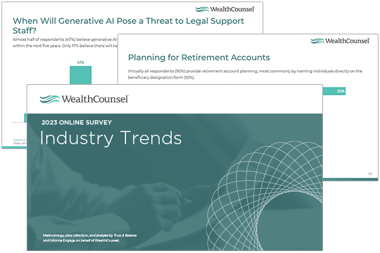
The estate tax exemption amount has more than doubled since 2017. However, unless Congress takes further action, the exemption amount authorized by the Tax Cuts and Jobs Act (TCJA) will revert to its previous levels at the end of 2025. As an estate planning attorney, you can help your clients by employing certain estate planning strategies over the next two years before the sunset of the higher exemption amount. Keep reading to learn how your clients may be affected and how you may be able to assist them.
Understanding Estate Planning and the TCJA
According to the Tax Foundation, Congress set the original basic exclusion amount (BEA) at $50,000 back in 1916. The number doubled to $100,000 in 1926, but reverted to its original level in 1932. The lowest level for the BEA was $40,000 during World War II. The number steadily increased over the years and hit $1 million for the first time in 2002.
The current fixed number for the BEA is $5 million, as stated by Internal Revenue Code 2010(c)(3), for taxpayers who passed away in 2010. The TCJA doubled that amount for those who died in 2018. The BEA has risen each year, and it stands at $13.61 million in 2023. That means that a married couple has a combined BEA of $27.22 million.
However, these numbers are set to sunset at the end of 2025, when the BEA will drop back to $5 million, indexed for inflation—which likely means the BEA will be somewhere between $6 million and $7 million per individual. Keep in mind that this scenario could change by an act of Congress.
Strategies to Consider
With the lifetime exemption amount currently at an all-time high, your clients can take advantage of the opportunity to make large gifts. Fortunately, the Internal Revenue Service has confirmed that estates making large gifts before the end of 2025 will not be penalized with a “clawback” in the future.
Clients can also reduce their taxable estates by making annual gifts. The annual gift tax exclusion amount (the amount that can be gifted without having to file a gift tax return) is $18,000 per recipient in 2024. This means that, in 2024, any person can give $18,000 per recipient annually to an unlimited number of people without triggering any gift tax obligations. As its name implies, the annual gift tax exclusion amount changes yearly and has increased by $1,000 in each of the last three years. Like the lifetime BEA amount, the annual gift exclusion is, effectively, doubled for married couples. To the extent that a gift exceeds the annual gift tax exclusion, it triggers a gift tax reporting obligation whereby the excess portion is applied against the lifetime exclusion amount, effectively reducing the BEA available to the gift giver. However, unless the value of the gifts exceeds the unified lifetime gift and estate tax exclusion amount (which is $13.61 million per person in 2024), no gift tax is actually owed.
Another estate planning strategy is a dynasty trust, which allows a client’s assets to be passed down to future generations. Although gift tax may apply upon funding the dynasty trust, it applies only to the gift in excess of the lifetime gift and estate tax exemption. A dynasty trust may also be subject to generation-skipping transfer (GST) tax. However, gift tax and GST tax are only paid once, and a properly structured dynasty trust should be able to avoid further transfer taxation while benefiting future generations.
An irrevocable life insurance trust (ILIT) can also protect your clients’ interests. Generally, the value of a life insurance policy is includable in the estate of the policy owner and could therefore be subject to estate taxes, but the benefit of the ILIT structure is that the value of the life insurance policy is kept out of the client’s taxable estate.
A client who wants to donate to a student’s higher education can also make an accelerated 529 plan gift. This means that the donor can make five years’ worth of contributions to a 529 plan in a single year. These front-loaded contributions can add up to $85,000 per student.
Before Sunset
According to the recent Industry Trends Survey that WealthCounsel conducted with Trusts & Estates magazine, 57 percent of respondents believe that at least half of their clients will be affected by the planned sunset of the exemption amount. For more insights on estate planning trends and technology, view the full results of the survey here.
Download the full 2023 Industry Trends Survey for free to see the latest opportunities and challenges for estate planning professionals.



.png)